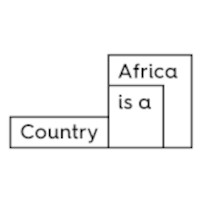South African companies can afford to pay their workers a living wage—if not for their commitment to profit shifting, as the case of Lonmin and Marikana showed.
Occupy Oakland march in solidarity with South Africa Miners Aug 24, 2012. Image credit Daniel Arauz via Flickr CC BY-SA 2.0.
This post forms part of our continued reflections on the legacy of the Marikana massacre, which also included the symposium “Marikana, 10 years on,” that took place on August 20th at Constitution Hill in Johannesburg.
Since the 19th century, South Africa’s political economy has been structured around the Minerals-Energy Complex (MEC)—the integration between mining, energy, and other upstream sectors (like steel) continues to shape the country’s post-apartheid economic structure. Cheap labor, migration, fossil fuel-powered energy, and uneven spatial development are central features of the MEC. In post-Apartheid South Africa the character of the MEC changed following the rapid deregulation of financial markets through the phasing out of capital and exchange controls beginning in 1995. Increased emphasis was placed on investing in financial markets coupled with the growth of the financial services sector, leading to the financialisation of the post-Apartheid South African economy. A significant shift producing a finance-led MEC development path over the past 28 years. Consequently, South Africa’s political economy has become over-reliant on the financial sector and capital markets, as well as the speculative and consumption-based economic activities associated with this finance-led growth trajectory. There is an abundance of literature on the adverse socio-economic impacts of this structural shift in the economy. But Seeraj Mohamed highlights the most important outcome, in that it has allowed large corporations to “selectively withdraw from the economy, as they internationalised and restructured in response to the pressures of financialisation and the shareholder value movement.” In other words: profit shifting, increased shareholder value and lessened regulation of international financial flows are key markers of South Africa’s finance-led MEC.
The wage demands made at the Association of Mineworkers and Construction Union (AMCU) commemoration of the 10th Anniversary of the Marikana Massacre in Rustenburg on August 16 exemplify workers’ responses to the structural shift towards enhanced financialisation. These demands for a decent living wage challenge both financialisation and the systemic exploitation of cheap black labor, which have characterized the MEC for decades. The demand by rock drill operators (RDOs) at Lonmin for a wage of R12,500 ($720 USD) per month, viewed as a living wage, was one of the important developments arising from the Marikana Moment. This was more than double the basic wages RDOs earned at the time, marking a radical departure from wage demands tabled by the unions previously. At the peak of the strike, some 200 000 mineworkers downed tools. The militancy of the striking workers coupled with the audacity of the demands captured the imagination of many other workers in the country. Fittingly, many others commemorated the anniversary—not only to pay tribute to the nearly 50 mineworkers who were murdered and the devastating impact it continues to have on their families, but also because of the watershed political moment that the Marikana Massacre represents.
Following the massacre, the Alternative Information Development Centre (AIDC) was allowed to access the audited financial statements of Lonmin’s subsidiaries in South Africa. The Farlam Commission of Inquiry wanted an investigation into whether or not Lonmin was in a financial position to meet the workers’ wage demands, since Lonmin’s management originally refused to negotiate with the workers on the pretense that the corporation was unable to afford the workers’ wage demands.
From analyzing the financial statements AIDC uncovered that up to 2012 Lonmin’s subsidiary, Western Platinum Limited (WPL), paid sales commissions of, on average, R250 million annually to a Lonmin subsidiary called Western Metal Sales Ltd (WMS) based in Bermuda (a notorious tax haven). The address for this Lonmin-linked outfit was also the address of the law firm Appleby Services, which specializes in offshore arrangements. This payment was made for the alleged sale of Lonmin’s platinum. Yet, WMS was a bank account, not a functioning sales company.
At the end of the Farlam Commission hearings, a public spat broke out about “The Bermuda Connection,” the report that the AIDC released on Lonmin’s shady finances. Lonmin claimed that WMS had been closed in 2008. Both “sales commissions” and “management fees” had since allegedly been paid to the SA group company Lonmin Management Services (LMS). The books of WPL, audited by KPMG, however, accounted for continued payments to WMS after that as well as “management fees” to LMS.
Lonmin’s Chief Financial Officer Simon Scott provided testimony on LMS’ finances. That testimony, read with other documents, showed that LMS, a so-called “Head Office company,” in turn paid management fees to Lonmin PLC in the UK of between 20% and 37% of its revenue, amounting to R429 million between 2007 and 2010.
Transactions made for the sole purpose of shifting profits are called transfer mispricing. Transfer mispricing is but one of the tools in transnational corporations’ (TNCs) bag of tricks, used to reduce the profits declared in countries with higher corporate income tax levels—like South Africa—and reduce companies’ tax liabilities. The profits end up in tax havens like Bermuda and London, where there are high levels of financial secrecy and corporate income tax rates are zero or negligible. There is no economic substance behind these transactions in that they do not add any value.
Critically, if Lonmin did not shift profits out of the country, it could have afforded the RDOs’ wage demands. In this way the Lonmin case illustrated that the state’s potential loss of revenue from the corporate income tax (CIT) is only but a fraction of the total losses incurred to the South African society.
Moreover, profit shifting leaves nothing left for social investments in mining-affected communities. This shortcoming is significant because workers’ wage demands are intrinsically connected with social reproduction and livelihood costs in these municipalities. Mineworkers reside in areas that barely provide citizens with adequate public goods and services. Public discourses on living wages often neglect this factor in assessing worker and family socio-economic needs. Additionally, workers’ wages need to be supplemented by broader, state-driven social policy measures, which decrease the costs of living significantly. Profit shifting deprives the state and mining communities from using mining sector profits for financing public social policy interventions. Lonmin’s local companies had legally binding obligations to implement a Social Labor Plan (SLP). In the 2006 SLP, the local companies committed to build 5,500 houses for mineworkers in five years. This became a focus in the cross examination of Lonmin’s Mr. Seedat about “the Bermuda Connection.” In 2011, Lonmin had built three show houses, alleging that there had been no resources.
Lonmin is but one example of a much bigger problem. The South African Revenue Service (SARS) estimates that the country loses approximately R100 billion in tax revenue annually as a result of Illicit Financial Flows (IFF) and Base Erosion and Profit Shifting (BEPS). At a corporate tax rate of 27%, a R100 billion tax loss means that more than R350 billion leaves the country illicitly each year. In terms of monetary value, the loss in wages to workers and abandoned SLP obligations are even greater than the erosion of the tax base. Wage evasion is very much a blind spot in the discussion on IFFs and BEPS.
A focus on a living wage represents an important demand in the country considering the perpetuation of the highest level of income inequalities in the world. A recent report indicates that more than 75% of workers earn below R5,800 per month. At the same time, SARS estimates that an estimated 500,000 people earn above R750,000 per annum, and approximately 250,000 people earn more than R1 million each year . The high level of income inequalities has grown over the past three decades given mass unemployment and a low-wage regime. Based on the lessons of the Marikana Massacre and what played out later in the Farlam Commission, radically improving workers’ wages is entirely possible if we put an end to the deleterious practices of transnational corporations. The unions simply have to engage with the profit shifting issue.






